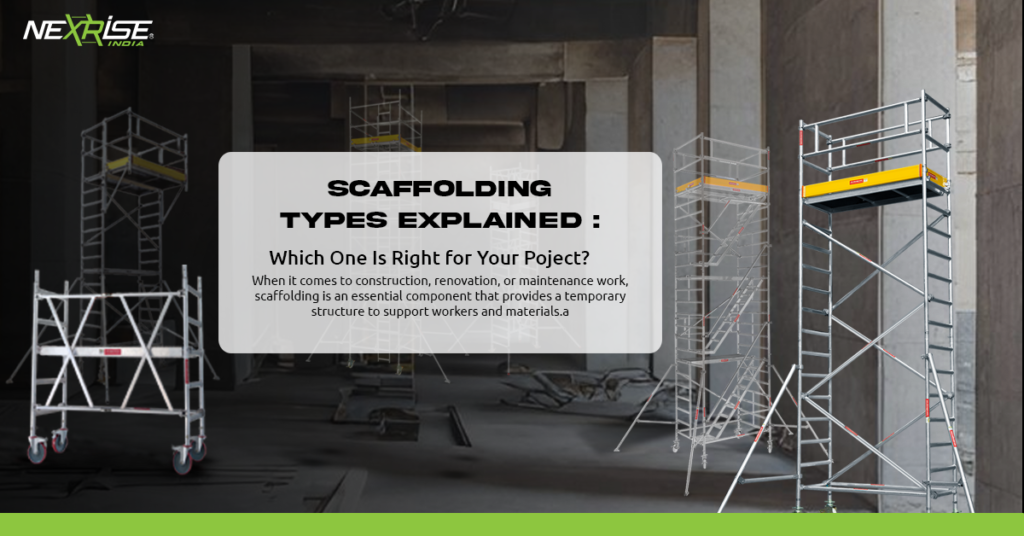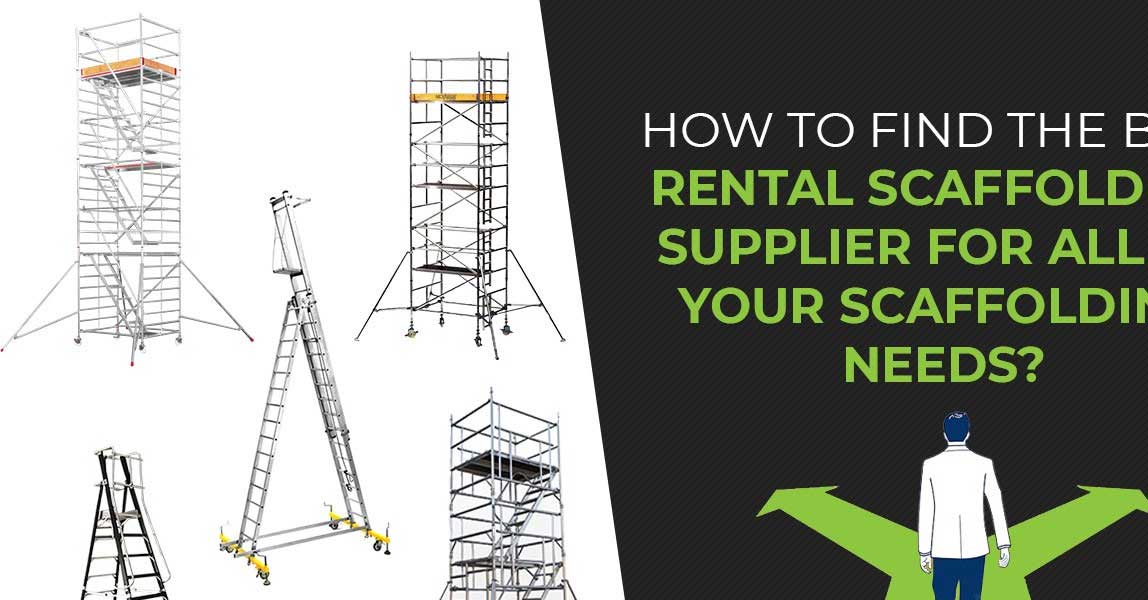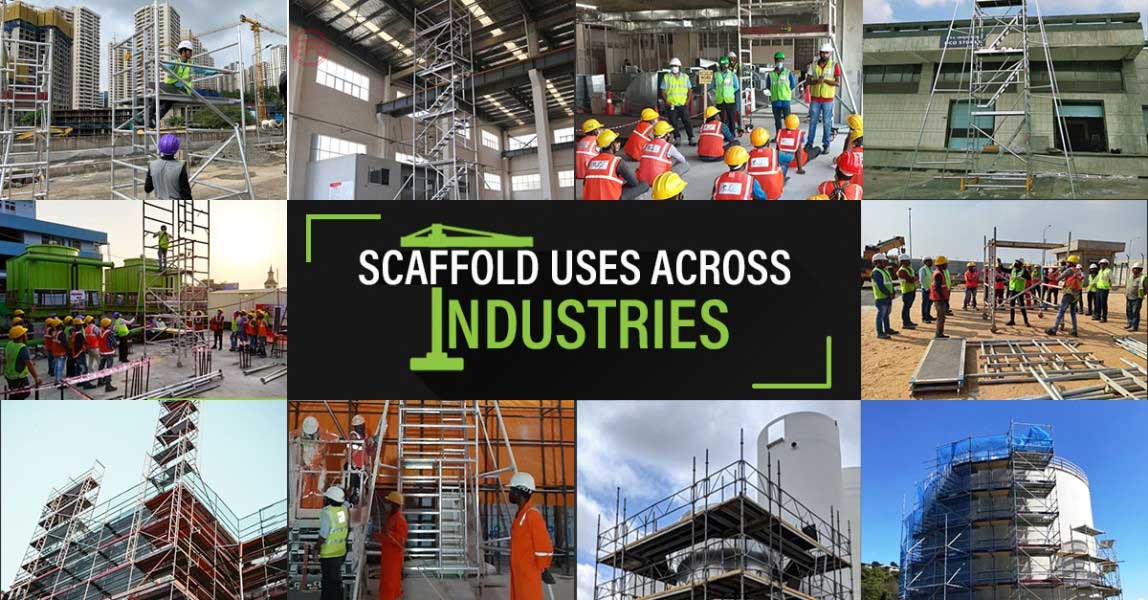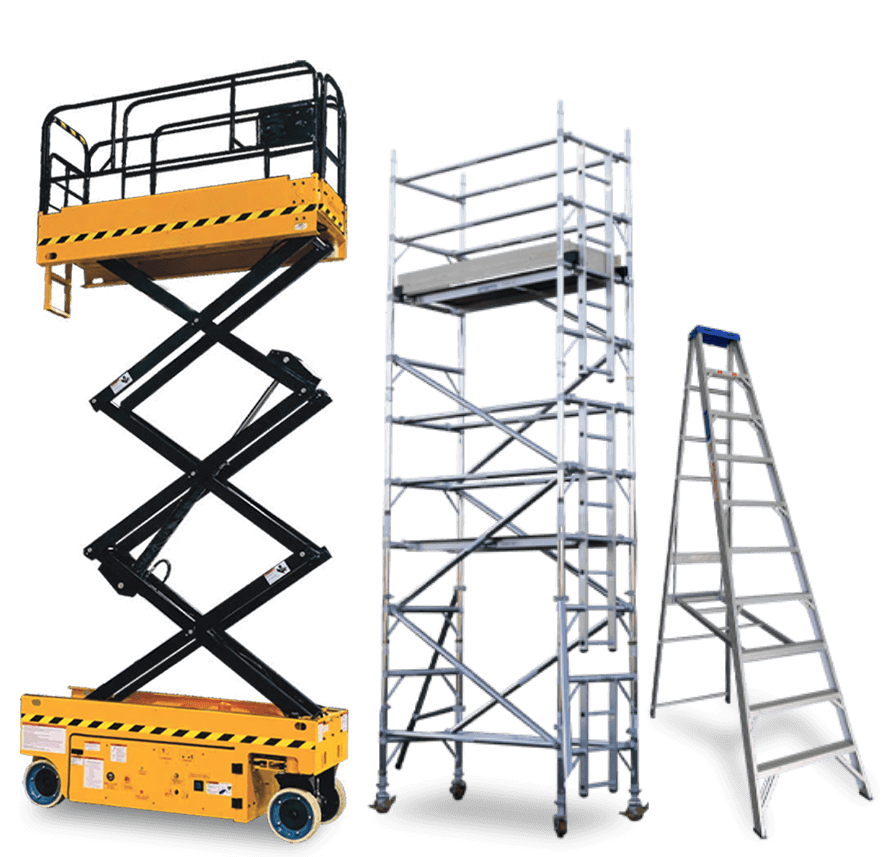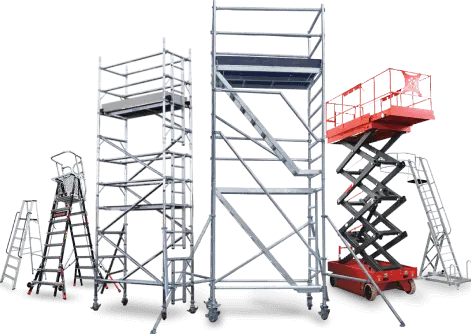When it comes to construction, renovation, or maintenance work, scaffolding is an essential component that provides a temporary structure to support workers and materials. Choosing the right type of scaffolding can make a significant difference in safety, efficiency, and overall project success. This guide will walk you through the different types of scaffolding and help you determine which one is best suited for your project.
1. Narrow Version Scaffold
When working on construction or renovation projects in confined areas, a standard scaffold may not always be the best fit. This is where the narrow version scaffold comes into play. Designed specifically for tight or restricted spaces, narrow version scaffolding provides a safe and effective platform for workers while maximizing maneuverability in areas where larger scaffolds can’t reach.
Let’s explore what narrow version scaffolds are, their benefits, and how to determine if they’re the right choice for your project.
Benefits of Narrow Version Scaffolding
- Ideal for Confined Spaces: Narrow version scaffolding is specifically designed for use in areas where space is limited, such as between buildings, in narrow hallways, or on staircases. Its compact size allows it to be positioned in spots where traditional scaffolding cannot be used, providing safe access to work areas that would otherwise be difficult to reach.
- Enhanced Maneuverability: With its slim design, a narrow version scaffold is easy to maneuver around obstacles and through tight spaces. Many narrow scaffolds are equipped with lockable wheels, allowing workers to move the scaffold quickly and safely from one location to another without dismantling and reassembling.
- Lightweight and Portable: Made from materials like aluminum, narrow scaffolds are lightweight and portable. This makes them easy to transport to different job sites and reduces the physical strain on workers during setup and takedown. Additionally, their lightweight nature minimizes the risk of damage to floors or surfaces, making them ideal for indoor use
- Adjustable Heights: Most narrow version scaffolds offer adjustable platform heights, enabling workers to reach various elevations without needing to switch equipment. This feature makes them versatile for multiple tasks, such as painting, plastering, electrical work, and maintenance in both residential and commercial settings.
- Quick and Easy Assembly: Narrow scaffolds are designed for quick assembly and disassembly. Their straightforward design allows workers to set them up in a matter of minutes, reducing downtime and enhancing productivity on the job site.
2. Stairway Tower Version Scaffold
When it comes to ensuring safe and efficient access to elevated work areas, the Stairway Tower Scaffold stands out as a preferred choice in many construction and maintenance projects. This types of scaffolding is designed with a built-in stairway, providing a secure and convenient means for workers to move up and down the scaffold structure. Let’s explore the features, benefits, and best uses of the Stairway Tower Scaffold to help you decide if it is the right scaffolding for your project.
Key Features of Stairway Tower Scaffold
- Built-in Staircases: Unlike traditional scaffolding with ladders, the stairwell tower scaffold features an integrated staircase with handrails, providing safer and more comfortable access for workers.
- Stable Structure: The scaffold is supported by a robust frame that ensures stability and can be configured to different heights depending on the project requirements.
- Modular Design: Stairway tower scaffolds are modular, meaning they can be customized and extended as needed. This flexibility allows for easy adaptation to various construction site conditions and height requirements.
- High Load Capacity: The platform and stairways are designed to support heavy loads, making them suitable for carrying tools, equipment, and materials up and down the structure.
Considerations When Choosing a Stairway Tower Scaffold
- Project Requirements: Assess the specific needs of your project, including the height, weight capacity, and frequency of access required. Stairway tower scaffolds are best for jobs that demand regular movement between multiple levels.
- Site Conditions: Ensure that the ground is stable and level for setting up the scaffold. The scaffold’s base must be properly supported to prevent tipping or collapse.
- Budget and Availability: While stairway tower scaffolds provide numerous benefits, they can be more expensive than traditional types of scaffolding. Consider your budget and the availability of this types of scaffolding in your area.
3. Ladder Frame Version Tower Scaffold
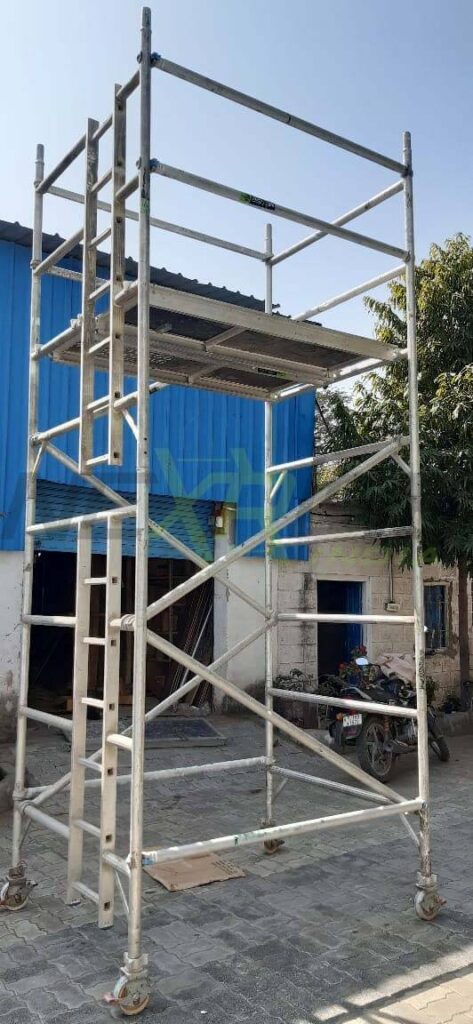
A Ladder Version Tower Scaffold is a versatile and practical scaffolding option, often used for both indoor and outdoor tasks that require reaching moderate heights. This types of scaffolding incorporates a ladder integrated into a tower structure, providing a convenient and safe way to ascend and descend the platform.
Key Features of Ladder Version Tower Scaffold
- Integrated Ladder System: The most distinctive feature is the built-in ladder, which provides quick and safe access to different working levels without needing a separate ladder or climbing apparatus.
- Adjustable Platform Heights: The tower typically includes multiple platforms that can be adjusted to different heights, accommodating various tasks and working conditions.
- Lightweight and Portable: Made from materials like aluminum, these scaffolds are designed to be lightweight and easy to maneuver, making them suitable for projects that require frequent repositioning.
- Wheeled Base: Equipped with wheels or casters, the scaffold can be moved effortlessly across flat surfaces, enhancing flexibility and efficiency on the job site.
Best Applications for Ladder Version Tower Scaffold
- Painting and Decorating: Provides a stable platform for painters and decorators to reach higher walls, ceilings, and hard-to-access areas.
- Building Maintenance: Useful for tasks such as changing light fixtures, cleaning windows, or repairing small building components.
- Electrical and Plumbing Work: Allows electricians and plumbers to safely access wiring, fixtures, and pipes at various heights.
- Residential Renovations: Ideal for home improvement projects that require moderate elevation, such as installing drywall, tiling, or wallpapering.
4. Cantilever Scaffolding
Cantilever scaffolding, also known as needle scaffolding, is a specialized types of scaffolding system that is designed to provide a platform in situations where ground-level support is impractical or impossible. This method involves projecting a scaffold from a structure or building, using a series of needles or brackets anchored into the walls.
How Does Cantilever Scaffolding Work?
Cantilever scaffolding works by transferring the load from the scaffold to the structure itself, bypassing the need for ground support. Here’s a basic breakdown of how it is set up:
- Needles or Brackets: Steel or wooden beams (needles) are inserted through holes in the wall or anchored securely to the building. These needles act as the primary support for the scaffolding.
- Transoms and Standards: Horizontal and vertical components, known as transoms and standards, are then attached to the needles to create a stable frame.
- Platform and Guardrails: The working platform is installed, along with guardrails and toe boards to ensure safety.
- Counterweights (if needed): Sometimes, counterweights are used on the inner side of the building to balance the scaffold’s load and maintain stability.
When to Use Cantilever Scaffolding?
Cantilever scaffolding is ideal for situations where conventional scaffolding is not feasible. Some common scenarios where cantilever scaffolding is used include:
- Limited Ground Access: When the ground is uneven, fragile, or not strong enough to support scaffolding, cantilever scaffolding provides a stable alternative.
- Obstructions: In cases where there are ground-level obstacles such as roads, footpaths, or other structures, cantilever scaffolding allows work to proceed without disrupting traffic or pedestrian flow.
- High-rise Buildings: For construction or maintenance work on high-rise buildings, cantilever scaffolding provides safe access to higher levels without requiring a scaffold base at the ground level.
Advantages of Cantilever Scaffolding
- Space-Saving: Ideal for situations where ground space is limited or unavailable.
- Flexible Access: Provides access to hard-to-reach areas, making it suitable for complex structures.
- Quick Setup: Can be assembled relatively quickly, saving time and reducing labor costs.
- Reduced Ground Obstruction: Prevents obstruction of pathways, roads, or work areas below.
5. One-Man Version Tower Scaffold
When it comes to smaller construction, maintenance, or DIY projects, a full-size scaffolding system can often be overkill. For these cases, a one-man version tower scaffold offers an ideal solution. Lightweight, portable, and easy to set up, this types of scaffolding is designed for solo workers who need a safe and stable platform for tasks at moderate heights.
Tips for Choosing the Right One-Man Version Tower Scaffold
- Determine the Maximum Working Height: Choose a scaffold with a platform height that suits the height requirements of your project. Ensure the scaffold can reach the necessary elevation safely without compromising stability.
- Check Weight Capacity: Ensure the scaffold can safely support your weight, along with any tools or materials you will be using. Most one-man tower scaffolds have weight capacities ranging from 200 to 400 pounds, so be sure to check the specifications.
- Look for Safety Certifications: Opt for a scaffold that meets relevant safety standards and certifications, such as OSHA (Occupational Safety and Health Administration) in the U.S. or EN (European Norms) standards in Europe.
- Consider Mobility Needs: If your project involves moving frequently from one location to another, choose a scaffold with high-quality wheels or casters that can be locked securely in place.
- Evaluate the Ease of Setup: Look for scaffolds with simple assembly instructions and minimal components. Snap-lock mechanisms or folding designs can make setup and teardown much quicker.
Benefits of Using a One-Man Version Tower Scaffold
- Cost-Effective: For smaller-scale projects, a one-man tower scaffold is a more affordable option compared to larger scaffolding systems. It eliminates the need for multiple workers and reduces the time spent on setup and dismantling.
- Versatile Applications: This types of scaffolding is suitable for a wide range of applications, including painting, plastering, electrical work, window cleaning, and general maintenance. Its compact size makes it ideal for use in confined spaces, such as hallways or narrow alleys.
- Improved Efficiency: Because it can be assembled, moved, and operated by a single person, a one-man tower scaffold significantly improves efficiency on the job site. It reduces downtime associated with setup and repositioning, allowing workers to focus on their tasks.
- Enhanced Safety: Unlike ladders, which can be unstable and prone to slipping, one-man tower scaffolds provide a stable and secure platform for working at height. The guardrails and non-slip surfaces reduce the risk of falls, making them a safer alternative for solo workers.
6. Folding Version Tower Scaffold
When working on smaller-scale projects or in confined spaces, traditional scaffolding can sometimes be too bulky or cumbersome. Enter the Folding Version Tower Scaffold — a compact, versatile, and easy-to-use scaffolding option that is gaining popularity among contractors, painters, electricians, and DIY enthusiasts alike. In this guide, we’ll explore what makes a folding version tower scaffold unique, its benefits, and the ideal scenarios for its use.
Choosing the Right Folding Version Tower Scaffold for Your Needs
When selecting a folding version tower scaffold, consider the following:
- Height Requirements: Make sure the scaffold’s maximum height is suitable for the tasks you need to perform. Check if it has an adjustable platform to cater to different heights.
- Load Capacity: Verify that the scaffold can support the weight of both workers and materials. Look for models with a robust frame and a platform capable of handling your project’s load requirements.
- Wheel Quality: Ensure the wheels are durable, easy to lock, and provide adequate stability on various surfaces.
- Material: Opt for scaffolds made from high-quality materials like aluminum for lightweight durability or steel for heavier-duty applications.
Benefits of Using a Folding Version Tower Scaffold
- Ease of Use: With its quick assembly and lightweight design, a folding tower scaffold can be set up and moved by one person, making it an excellent choice for small teams or solo workers.
- Portability: Its compact and foldable design makes it easy to transport in standard vehicles, reducing the need for larger transportation equipment. This portability makes it ideal for jobs that require moving between multiple locations.
- Versatility: Suitable for both indoor and outdoor tasks, the folding tower scaffold is perfect for a range of activities, from painting and decorating to light construction work, cleaning, and maintenance.
- Space-Saving: When not in use, the scaffold folds flat, allowing it to be stored in minimal space. This is particularly beneficial for small workshops, homes, or any site with limited storage capacity.
- Safety: Despite its compact size, the folding version tower scaffold offers a stable and secure platform, complete with safety rails and non-slip surfaces to prevent falls and accidents.
Conclusion
A Folding Version Tower Scaffold is an excellent choice for professionals and DIY enthusiasts who need a versatile, portable, and space-saving scaffolding solution. With its lightweight design, easy assembly, and compact storage capabilities, it’s perfect for a wide range of projects, both indoors and outdoors. Whether you’re painting a room, fixing a ceiling, or tackling a home improvement task, a folding version tower scaffold offers a safe, efficient, and practical solution to meet your needs.
By considering the specific requirements of your project and choosing a scaffold that fits those needs, you can enhance both safety and productivity on the job.
If you want to buy or rent our aluminium scaffolding. Feel free to call us!
Read more: What are Scaffold Tagging and Types?

